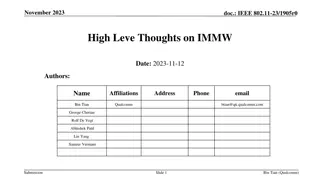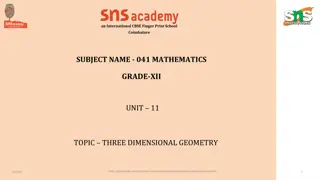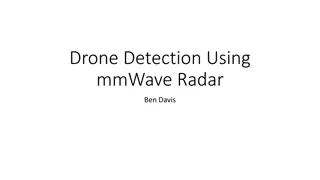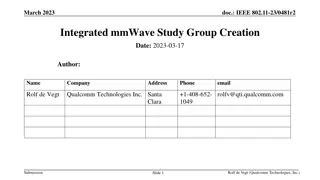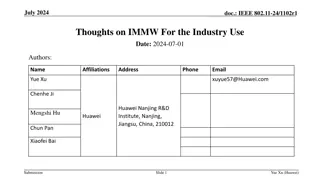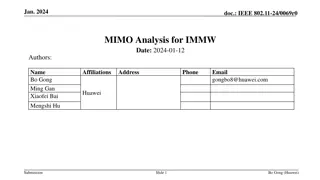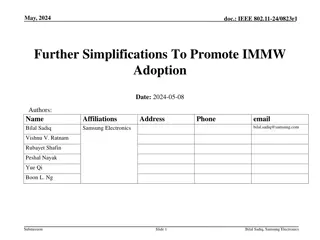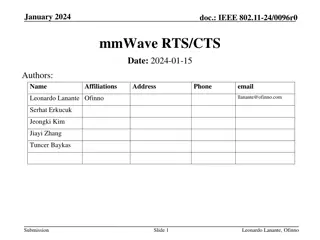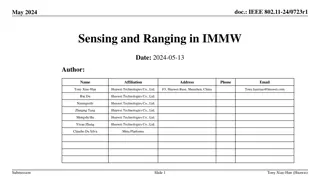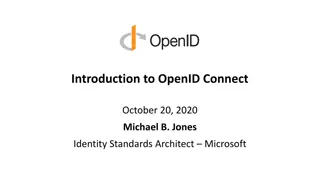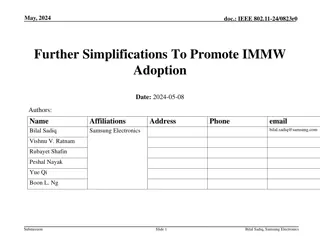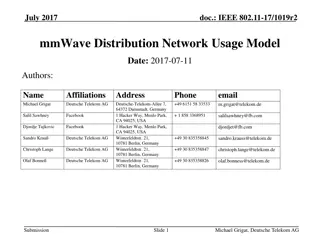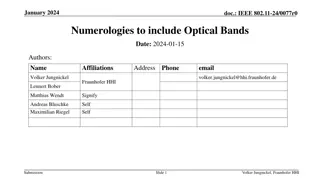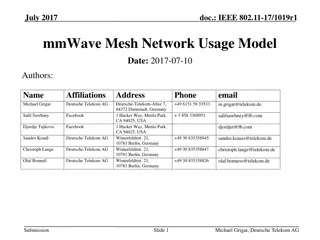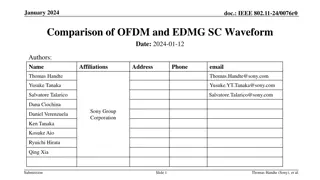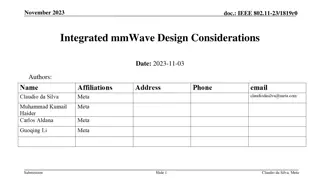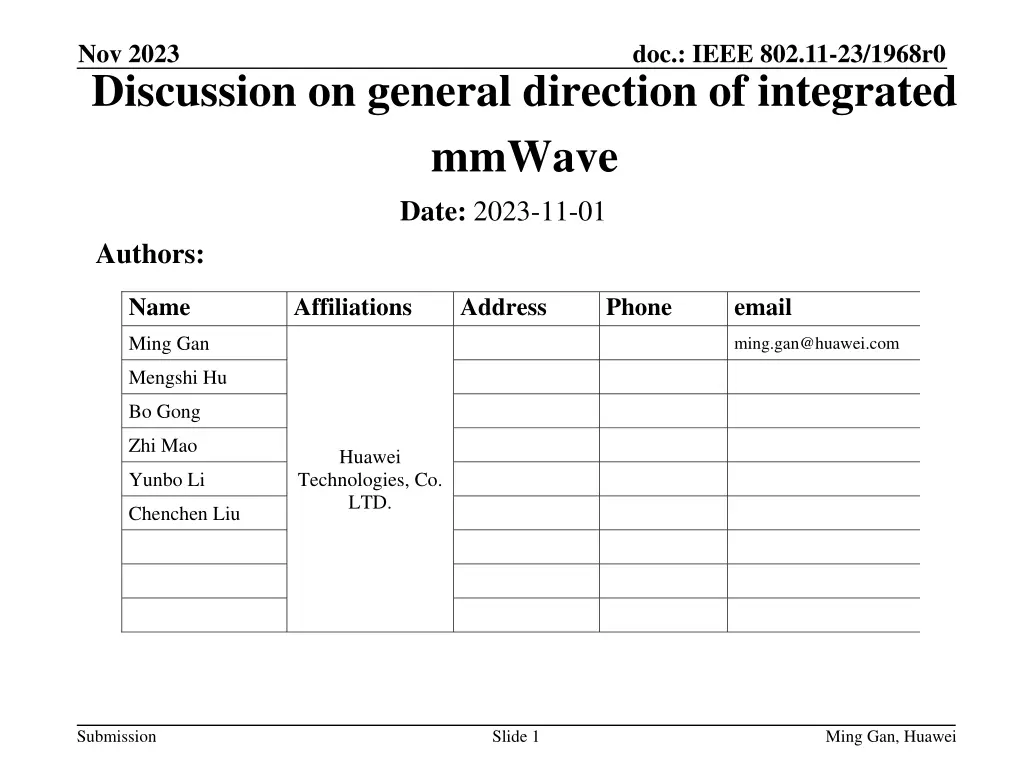
Integrated mmWave Technology Advancements in IEEE 802.11-23/1968r0 Document
Explore the latest developments in integrated mmWave technology within the IEEE 802.11-23/1968r0 document, discussing the formation of a Study Group and the planned MAC/PHY specifications for carrier frequency operation between 42.5 and 71 GHz. Discover how integrated mmWave technology is set to revolutionize Wi-Fi networks, enabling new use cases like fiber to the room (FTTR) and live streaming in dense environments. Dive into the details of leveraging MAC/PHY specifications in the Sub 7 GHz bands and the strategies for maximizing efficiency and performance.
Download Presentation

Please find below an Image/Link to download the presentation.
The content on the website is provided AS IS for your information and personal use only. It may not be sold, licensed, or shared on other websites without obtaining consent from the author. If you encounter any issues during the download, it is possible that the publisher has removed the file from their server.
You are allowed to download the files provided on this website for personal or commercial use, subject to the condition that they are used lawfully. All files are the property of their respective owners.
The content on the website is provided AS IS for your information and personal use only. It may not be sold, licensed, or shared on other websites without obtaining consent from the author.
E N D
Presentation Transcript
Nov 2023 doc.: IEEE 802.11-23/1968r0 Discussion on general direction of integrated mmWave Date: 2023-11-01 Authors: Name Affiliations Address Phone email Ming Gan ming.gan@huawei.com Mengshi Hu Bo Gong Zhi Mao Huawei Yunbo Li Technologies, Co. LTD. Chenchen Liu Submission Slide 1 Ming Gan, Huawei
Nov 2023 doc.: IEEE 802.11-23/1968r0 Background The following motion [1] was agreed in March 2023 Form an 802.11 Integrated mmWave Study Group (IMW SG) to develop a Project Authorization Request (PAR) and a Criteria for Standards Development (CSD) for a new 802.11 MAC/PHY amendment which specifies carrier frequency operation between 42.5 and 71 GHz and leverages MAC/PHY specifications in the Sub 7 GHz bands The target start date of the Study Group is November 2023 Integrated mmWave [2-5] is pretty promising for the whole Wi-Fi industry Perfectly cater for the new use cases, such as fiber to the room (FTTR) [3], live steaming in the closed office cubicles. Good to frequency reuse with a large bandwidth in enterprise/dense deployments. Point out a long-term Wi-Fi evolutional roadmap given that there is no light house feature in UHR. Open path to commercialize new features/applications, such as ranging and sensing. In this contribution, we discuss the general direction of integrated mmWave Submission Slide 2 Ming Gan, Huawei
Nov 2023 doc.: IEEE 802.11-23/1968r0 Leverages MAC/PHY specifications in the Sub 7 GHz Before we proposed to reuse sub 7GHz PHY in [3] together other contributions [5-9] Upclock current sub 7GHz PHY by X times such that to increase subcarriers space and keep single PHY mode-OFDM Configure the channel width by taking into current support channel width in sub 7GHz and its evolution tendency Reuse Sub 7 GHz PHY modules as much as possible, like FFT size, tone mapper/interleaver, coding, MCS and so on Beside the items mentioned above, we should make sure that hardware/computing resource does not require great-leap-forward increment The supported bandwidth should be decreased, no longer starts with 2.16GHz since it involves filter, ADC/DAC, sampling rate and so on Non-contiguous channel bonding should not be allowed Submission Slide 3 Ming Gan, Huawei
Nov 2023 doc.: IEEE 802.11-23/1968r0 Leverages MAC/PHY specifications in the Sub 7 GHz Given the maximum mandatory support bandwidth (80 MHz) in sub 7 GHz and its steady evolution. Recommend 80/160 MHz as minimum bandwidth in mmWave band. 80 MHz is preferred at the client side given that lots of current clients still support 80 MHz at most, and 160 MHz is preferred at the AP side; Doubling their corresponding sizes is also ok MAC components in sub 7 GHz should also be reused as much as possible, those from 802.11ad/ay should not be inherited if they are covered by sub 7GHz MAC Discovery procedure BSS operation, including static puncture for radar coexistence Association/multi-link setup Acknowledgement procedure Power management Sounding operation Submission Slide 4 Ming Gan, Huawei
Nov 2023 doc.: IEEE 802.11-23/1968r0 Integrated mmWave with MLO There is no mmWave band only device. Thanks to the key feature-MLO in 802.11be, this feature should be incorporated in integrated mmWave design Mitigate power consumption with only one awake sub 7GHz link in monitoring status Address the blockage issue of mmWave band with the help of a sub 7GHz link. With MLO, control PHY should not be taken into account. Instead, most control/management frames are moved to Sub 7GHz. Control PHY decreases the data rate significantly, resulting in low spectrum usage. Additional mode of control PHY adds complexity to the implementation. With MLO, beam training procedure should also be tuning, e.g., reusing sounding procedure. Submission Slide 5 Ming Gan, Huawei
Nov 2023 doc.: IEEE 802.11-23/1968r0 Backward compatibility and coexistence In 802.11ad/ay, the minimum bandwidth is 2.16 GHz, however, in 802.11aj, the minimum bandwidth is 540 MHz. According to the passed motion shown in slide 2, integrated mmWave design should take both 45 GHz and 60GHz into account . Moreover, integrated mmWave design should also be unified for them, including channelization (if regulation allows) Given current status of commercial products about 802.11ad/ay/aj, only energy detection is needed for coexistence with legacy IEEE 802.11 ad/ay/aj and backward compatibility should be waived in order to reduce the burden and complexity Channelization for integrated mmWave should also not take the configuration of channel in 802.11ad/ay/aj into account, and could be fully redesigned. Submission Slide 6 Ming Gan, Huawei
Nov 2023 doc.: IEEE 802.11-23/1968r0 Other thought Agree to [6] and [7], SU only transmission is preferred, and MU transmission should be moved to next gen of this IMMW MU transmission includes both OFDMA and MU-MIMO. SU-MIMO should not be excluded given its high data rate, although it has some complexity to some extent. 2 spatial streams is preferred from the aspect of practical scenarios. Other numbers could also be ready from the aspect of standard draft. Submission Slide 7 Ming Gan, Huawei
Nov 2023 doc.: IEEE 802.11-23/1968r0 Summary In this contribution, we suggest the following guidelines for IMMW Reuse PHY and MAC in sub 7GHz as much as possible MLO architecture with at least one sub 7GHz link should be incorporated Backward compatibility in mmWave band should not be considered Submission Slide 8 Ming Gan, Huawei
Nov 2023 doc.: IEEE 802.11-23/1968r0 References [1] 11-23-0481-02-0uhr-imw-sg-formation-motion-text [2] 11-22-0030-01-0wng-look-ahead-to-next-generation [3] 11-22-1083-01-0wng-next-generation-sg-formation [4] 11-22-0046-01-0wng-next-generation-after-802-11be [5] 11-22-0729-01-0wng-next-generation-after-802-11be-follow-up [6] 11-22-1595-01-0uhr-some-questions-to-answer-in-the-sg [7] 11-22-1872-00-0uhr-considerations-on-phy-designs-for- mmwave-band [8] 11-22-1395-00-0uhr-thoughts-on-high-frequency-band [9]11-23-0066-02-0uhr-thoughts-on-utiliizing-mmwave Submission Slide 9 Ming Gan, Huawei

